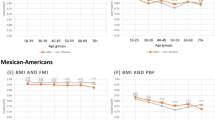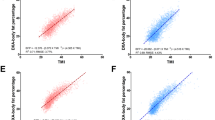Abstract
Objectives:
We aim to evaluate the ethnic-specific relationship of total fat mass and anthropometric indices in Chinese.
Design:
Cross-section study.
Setting:
This study was performed at the College of Life Sciences, Hunan Normal University, P.R. China.
Subjects and method:
To increase our understanding of the relationship of total fat mass and anthropometric indices in Chinese, 793 females and 1091 males aged 20–40 years were randomly recruited from Changsha city of P. R. China. Hip circumference (HC) and waist circumference (WC) were measured using standardized equipments, and other three anthropometric indices of body mass index (BMI), waist-to-hip ratio (WHR), and conicity index (CI) were calculated using weight, height, HC and WC. Total body fatness (TBF) in kg was measured using a Hologic QDR 4500 W dual-energy X-ray absorptiometry (DEXA) scanner.
Results:
There was an increasing trend of TBF, %TBF (percent total body fatness) and the five anthropometric indices in successively older age groups. Compared with females, males generally had high average BMI, WC, HC, WHR and CI, but had low average TBF and %TBF. Except for some correlations in 25–29 years age groups, TBF and %TBF were significantly correlated with five anthropometric indices with the Pearson's correlation coefficients ranging from 0.07 to 0.87. Principal component analysis (PCA) was performed to form four principal components (PCs) that interpreted over 99% of the total variation of the five related anthropometric indices in all age groups, with over 53% of the total variation accounted for by the PC1. Multiple regression analyses showed that four PCs combined explained a greater variance (R2=55.2–80.8%) in TBF than did BMI alone (R2=40–74.9%).
Conclusion:
Our results suggest that there is an increasing trend of total fat mass and five anthropometric indices with aging; that age and sex have the important effects on influencing the correlations of TBF and the studied anthropometric indices; and that the accuracy of predicting the TBF using five anthropometric indices is higher than using BMI alone.
This is a preview of subscription content, access via your institution
Access options
Subscribe to this journal
Receive 12 print issues and online access
$259.00 per year
only $21.58 per issue
Buy this article
- Purchase on Springer Link
- Instant access to full article PDF
Prices may be subject to local taxes which are calculated during checkout

Similar content being viewed by others
References
Blew RM, Sardinha LB, Milliken LA, Teixeira PJ, Going SB, Ferreira DL et al. (2002). Assessing the validity of body mass index standards in early postmenopausal women. Obes Res 10, 799–808.
Chang CJ, Wu CH, Chang CS, Yao WJ, Yang YC, Wu JS et al. (2003). Low body mass index but high percent body fat in Taiwanese subjects: implications of obesity cutoffs. Int J Obes Relat Metab Disord 27, 253–259.
Davies PS, Lanham DA, Stead MA, Tsang K (2001). Body mass index and the prediction of percentage body fat in Australian Chinese women. Ann Hum Biol 28, 467–470.
Deng FY, Liu MY, Li MX, Lei SF, Qin YJ, Zhou Q et al. (2003). Tests of linkage and association of the COL1A2 gene with bone phenotypes’ variation in Chinese nuclear families. Bone 33, 614–619.
Deurenberg P, Deurenberg Yap M, Wang J, Lin FP, Schmidt G (1999). The impact of body build on the relationship between body mass index and percent body fat. Int J Obes Relat Metab Disord 23, 537–542.
Deurenberg P, Deurenberg-Yap M, Schouten FJ (2002). Validity of total and segmental impedance measurements for prediction of body composition across ethnic population groups. Eur J Clin Nutr 56, 214–220.
Deurenberg P, Yap M, van Staveren WA (1998). Body mass index and percent body fat: a meta analysis among different ethnic groups. Int J Obes Relat Metab Disord 22, 1164–1171.
Duncan E, Schofield G, Duncan S, Kolt G, Rush E (2004). Ethnicity and body fatness in New Zealanders. N Z Med J 117, U913.
Eto C, Komiya S, Nakao T, Kikkawa K (2004). Validity of the body mass index and fat mass index as an indicator of obesity in children aged 3–5 year. Physiol Anthropol Appl Human Sci 23, 25–30.
Evans WJ, Campbell WW (1993). Sarcopenia and age-related changes in body composition and functional capacity. J Nutr 123, 465–468.
Frankenfield DC, Rowe WA, Cooney RN, Smith JS, Becker D (2001). Limits of body mass index to detect obesity and predict body composition. Nutrition 17, 55–56.
Goran MI, Driscoll P, Johnson R, Nagy TR, Hunter G (1996). Cross-calibration of body-composition techniques against dual-energy X-ray absorptiometry in young children. Am J Clin Nutr 63, 299–305.
Green PE (1978). Analyzing Multivariate Data. The Dryden Press: Hinsdale, Illinois.
Gurrici S, Hartriyanti Y, Hautvast JG, Deurenberg P (1999). Differences in the relationship between body fat and body mass index between two different Indonesian ethnic groups: the effect of body build. Eur J Clin Nutr 53, 468–472.
Han TS, van Leer EM, Seidell JC, Lean ME (1996). Waist circumference as a screening tool for cardiovascular risk factors: evaluation of receiver operating characteristics (ROC). Obes Res 4, 533–547.
He Q, Horlick M, Thornton J, Wang J, Pierson Jr RN, Heshka S et al (2002). Sex and race differences in fat distribution among Asian, African–American, and Caucasian prepubertal children. J Clin Endocrinol Metab 87, 2164–2170.
Heyward VH, Cook KL, Hicks VL, Jenkins KA, Quatrochi JA, Wilson WL (1992). Predictive accuracy of three field methods for estimating relative body fatness of nonobese and obese women. Int J Sport Nutr 2, 75–86.
Horber FF, Gruber B, Thomi F, Jensen EX, Jaeger P (1997). Effect of sex and age on bone mass, body composition and fuel metabolism in humans. Nutrition 13, 524–534.
Jackson AS, Stanforth PR, Gagnon J, Rankinen T, Leon AS, Rao DC et al. (2002). The effect of sex, age and race on estimating percentage body fat from body mass index: The Heritage Family Study. Int J Obes Relat Metab Disord 26, 789–796.
Janssen I, Heymsfield SB, Allison DB, Kotler DP, Ross R (2002). Body mass index and waist circumference independently contribute to the prediction of nonabdominal, abdominal subcutaneous, and visceral fat. Am J Clin Nutr 75, 683–688.
Jia WP, Lu JX, Xiang KS, Bao YQ, Lu HJ, Chen L (2003). Prediction of abdominal visceral obesity from body mass index, waist circumference and waist–hip ratio in Chinese adults: receiver operating characteristic curves analysis. Biomed Environ Sci 16, 206–211.
Ko GT, Tang J, Chan JC, Sung R, Wu MM, Wai HP et al. (2001). Lower BMI cut-off value to define obesity in Hong Kong Chinese: an analysis based on body fat assessment by bioelectrical impedance. Br J Nutr 85, 239–242.
Lanham DA, Stead MA, Tsang K, Davies PS (2001). The prediction of body composition in Chinese Australian females. Int J Obes Relat Metab Disord 25, 286–291.
Lindsay RS, Hanson RL, Roumain J, Ravussin E, Knowler WC, Tataranni PA (2001). Body mass index as a measure of adiposity in children and adolescents: relationship to adiposity by dual energy X-ray absorptiometry and to cardiovascular risk factors. J Clin Endocrinol Metab 86, 4061–4067.
Pietrobelli A, Faith MS, Allison DB, Gallagher D, Chiumello G, Heymsfield SB (1998). Body mass index as a measure of adiposity among children and adolescents: a validation study. J Pediatr 132, 204–210.
Roubenoff R, Dallal GE, Wilson PW (1995). Predicting body fatness: the body mass index vs estimation by bioelectrical impedance. Am J Public Health 85, 726–728.
Rush E, Plank L, Chandu V, Laulu M, Simmons D, Swinburn B et al. (2004). Body size, body composition, and fat distribution: a comparison of young New Zealand men of European, Pacific Island, and Asian Indian ethnicities. N Z Med J 117, U1203.
Smalley KJ, Knerr AN, Kendrick ZV, Colliver JA, Owen OE (1990). Reassessment of body mass indices. Am J Clin Nutr 52, 405–408.
Taylor RW, Jones IE, Williams SM, Goulding A (2000). Evaluation of waist circumference, waist-to-hip ratio, and the conicity index as screening tools for high trunk fat mass, as measured by dual-energy X-ray absorptiometry, in children aged 3–19 years. Am J Clin Nutr 72, 490–495.
Thomas GN, Ho SY, Lam KS, Janus ED, Hedley AJ, Lam TH, Hong Kong Cardiovascular Risk Factor Prevalence Study Steering Committee (2004). Impact of obesity and body fat distribution on cardiovascular risk factors in Hong Kong Chinese. Obes Res 12, 1805–1813.
Valdez R, Seidell JC, Ahn YI, Weiss KM (1993). A new index of abdominal adiposity as an indicator of risk for cardiovascular disease. A cross-population study. Int J Obes Relat Metab Disord 17, 77–82.
Vapnik V (1998). Statistical Learning Theory[M]. Wiley: New York.
Zhang Q, Du WJ, Hu XQ, Liu AL, Pan H, Ma GS (2004). The relation between body mass index and percentage body fat among Chinese adolescent living in urban Beijing. Zhonghua Liu Xing Bing Xue Za Zhi 25, 113–116. (in Chinese).
Acknowledgements
We thank three anonymous reviewers for their comments to improve this paper. The study was partially supported by a key project grant (30230210), a general grant (30470534) from National Science Foundation of China, three projects from Scientific Research Fund of Hunan Provincial Education Department (02A027, 03C226, 04B039), and a grant from Natural Science Foundation of Hunan Province (04JJ1004). Investigator H.W.D. was partially supported by grants from Health Future Foundation of USA, grants of National Health Institute (K01 AR02170-01A2, R01 GM60402 and 5R01 AR050496-02).
Author information
Authors and Affiliations
Corresponding author
Additional information
Guarantor: H-W Deng.
Contributors: SFL was responsible for the data analysis and writing of the manuscript. HWD is principal investigator and contributed to the study design and its implementation. YJL was involved in the revision of the manuscript. Other coauthors participated in sample recruitment, data preparation or manuscript preparation.
Rights and permissions
About this article
Cite this article
Lei, SF., Liu, MY., Chen, XD. et al. Relationship of total body fatness and five anthropometric indices in Chinese aged 20–40 years: different effects of age and gender. Eur J Clin Nutr 60, 511–518 (2006). https://doi.org/10.1038/sj.ejcn.1602345
Received:
Revised:
Accepted:
Published:
Issue Date:
DOI: https://doi.org/10.1038/sj.ejcn.1602345
Keywords
This article is cited by
-
The brain neuropeptides and STAT3 mediate the inhibitory effect of 17-β Estradiol on central leptin resistance in young but not aged female high-fat diet mice
Metabolic Brain Disease (2022)
-
Value of appendicular skeletal muscle mass to total body fat ratio in predicting obesity in elderly people: a 2.2-year longitudinal study
BMC Geriatrics (2020)
-
Application of conicity index adjusted total body fat in young adults-a novel method to assess metabolic diseases risk
Scientific Reports (2018)
-
Adiposity and blood pressure among 55 000 relatively lean rural adults in southwest of China
Journal of Human Hypertension (2015)
-
Gray and white matter structures in the midcingulate cortex region contribute to body mass index in Chinese young adults
Brain Structure and Function (2015)



